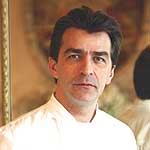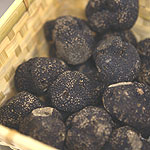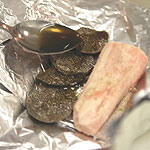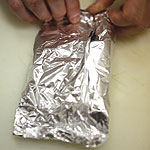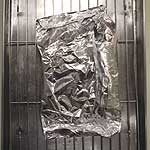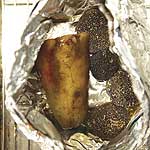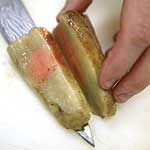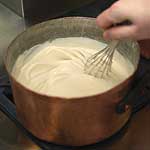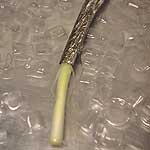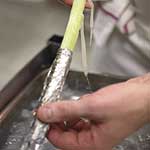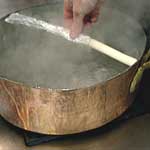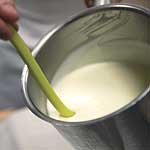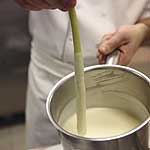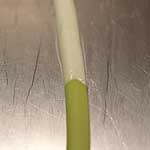Truffles masterclass with Yannick Alléno
Unlike some three-star chefs, Yannick Alléno is very hands-on and takes charge of the 74-strong brigade in the kitchen of Le Meurice in Paris every day. Despite this, he still finds time to be creative - something he sees as his main role. Michael Raffael reports
Every year the top table of three-star chefs grows more crowded. Yannick Alléno earned his seat in 2007. On the cusp of 40 years old, he brought a balance of flair and maturity. He's a chef with a hotel rather than restaurant background and is also very much a Parisian. Before moving to Le Meurice, he earned two stars at the Scribe. In his early career, he worked in kitchens at the Lutétia, Sofitel Sèvres and Royal Monceau.
It's a background that has shaped his opinions. Grand hotels, he believes, need a figurehead if their food and beverage operations are to succeed: "When there isn't a star chef in control it's rare for the restaurant to do well."
In London, we're used to the Ramsay, Ducasse, Darroze solutions where an outsider runs a flagship operation. At Le Meurice, chef Alléno is in overall charge of kitchens that service its luxury restaurant, Le Dali - one step up from a brasserie - and the banqueting. Managing a 74-strong brigade is a task that could interfere with his talent as an innovator. He prefers to prioritise his imagination. "I've organised things so that everything on the periphery is managed by others and I can make time for my main role, which is creative."
Providing that food and beverages is in the black, and it is - "we're making 14-15% net profit" - he has a licence to think outside the box. That freedom has produced wide-ranging results: a surreal "truffled chicken in a bottle", apparently based on his grandmother's recipe; a lightweight waiters' carbon tray; designs for the hotel's crockery; and the inevitable book, 101 Creations, in partnership with Japanese food writer Kazuko Masui.
When he says "I express my personality through my cooking", he echoes the ambition of most multi-starred chefs. Can a cuisine d'auteur, an individual style of cooking, exist inside France, where Escoffier's rules are rules? He doesn't see these as a handicap. In any case, they're evolving. "When authors write books, they're all using the same spelling and grammar, but styles vary and one will pull a best-seller out of the hat, whereas another will produce a turnip."
Having toured major capitals, he argues that "La Grande Cuisine" hasn't lost its edge. "We're still world leaders. Go to New York and check out the top restaurants - they're French. We have an instinctive savoir faire."
Closer to home, he's focusing on Paris. At the turn of the last century there were more than 150 regional foods specific to the area round the city known as L'Ile de France. He is working to revive produce that has either become extinct or is in danger of vanishing. Some, such as white Argenteuil asparagus or Montmorency cherries, were once household names. Others, such as the violet-ribbed Pontoise cabbage and Calville Blanche apple, are rarities.
He has also ratcheted up the seasonal food principle a notch. White truffles figure on his autumn menu, not the winter one, when Black Périgord truffles take their place, but they don't feature in spring, because the season ends in February. Rather than blast-freeze, a typical practice in top-end restaurants, he receives them direct from the courtiers buying in the truffle auctions.
With his own company, set up in 2009, his consultancies and endorsements - including a training deal with Compass - he has joined the stratosphere of chefs whose financial girths swell with outside interests. To fulfil his obligations he admits to working twice as hard as his staff. His chief pleasure, though, remains cooking and devising new dishes. "That", he confesses, "is what really keeps me happy."
TRUFFLE HUNTING
"If you have to ask the price, you can't afford it." A truism? It is when it comes to black truffles, yes, but not summer truffles, the autumnal Burgundy truffle and certainly not the Chinese truffle. We're talking upwards of £1,000 per kg for fresh Truffes de Périgord (tuber melanosporum).
Only a small fraction originates in this region of South-west France. More come from Provence, central Italy or northern Spain. With an annual harvest below 100 tonnes, these truffles are so rare that chefs will often pay whatever it takes to obtain them.
But this isn't always a good deal. Fresh out of the ground, big or small, they have an intense, persistent aroma and deserve, every bit of their reputation. Damaged through poor handling or slow distribution and their quality is eroded. Aiming to buy the best and paying the going rate is safer than looking for a bargain.
It's a market where the buyer really does have to beware. Chefs who do buy fresh truffles must turn them over fast. At Le Meurice, Yannick Alleno receives as many as three deliveries a week, because he knows the aroma dissipates.
The season is short, from December until February. Even some of the three-star fraternity will freeze what they buy. A dish described as "truffé", sold at Easter is bound to be based on either frozen, bottled or tinned raw materials.
Processing also reduces the flavour. Some products are boiled twice and only the juice in which they swim retains any real truffle taste. A chef intent on preserving truffles should keep them in sterilised kilner jars or in Armagnac.
Having committed to working with black truffles, chefs have to learn to cook with them. They aren't, like white truffles, something to sprinkle over a dish at the last minute. They benefit from cooking and they deliver a bigger hit when they're warm or hot.
FRENCH TRUFFLE GRADING
It's a useful rule of thumb, but no more. Insiders know that there are probably 20 different grades. However, "Extra" covers brushed truffles weighing over 30g each, generally round, unblemished and defect free. Category "1" can include smaller tubers or some external damage such as attack by animals - mice, slugs, and so on. Category "2" permits more imperfections and there's also an unclassified category that can include pieces of truffle.
Yannick Alléno Truffle
LEEK COATED IN A BECHAMEL CHAUDFROID, WITH TRUFFLE SLICES COOKED WITH BONE MARROW
INGREDIENTS (Serves one)
- 1 prepared "pencil" leek
- Salt
- Pepper
- 1 béchamel recipe (see page 22)
- 3-4 slices, 20g (approx) fresh truffle
- 5 cubes baked bone marrow
- 1tbs truffle jus
- Brioche cubes
- Clarified butter
- 20ml veal jus (approx)
CHECKING AND PREPARING FRESH TRUFFLES
Smell the truffles. The more powerful the scent, the fresher they are likely to be.
They should feel heavy in the hand. If it's spongy or damp, it may have been frozen or suffered frost damage.
Canifage, an essential check on quality. Most black truffles, regardless of type, can look similar on the outside. Yannick Alléno checks every one that's sent him by slicing off a sliver to verify that it's a tuber melanosporum. The real deal has an unmistakable network of fine white veins.
Also, if you scratch the surface with the tip of a knife, the colour of the scraping is reddish brown - "similar to a tennis clay court" according to the chef.
Smelling the truffle's cut surface is also an indication of ripeness. An immature truffle in perfect condition may lack perfume.
Brushing and cleaning. Water is the truffle's enemy. It must never be soaked. When it comes out of the ground it can have soil attaching to it. Every bit of it has to be removed with a brush. Typically, this will be done before the truffle reaches a professional kitchen, but the chef should check each truffle for traces of soil and remove them either with a brush or, if anything lodges in the crannies, a needle. Since the outer skin is going to provide the "jus de truffes" any dirt may spoil its taste.
Peeling. The rough, gnarled skin of the truffle has to be carefully peeled without cutting into its body. These trimmings will form the base of the truffle jus.
TRUFFLE JUS
Put all the trimmings from the preparation of your fresh truffles in a pan that's just big enough to hold them - probably the smallest pan in the kitchen. Cover with water and bring to the boil. Blend with a Bamix or similar. Cover, leave to infuse overnight and strain the liquid. Store in a sealed container.
BAKED BONE MARROW CUBES
In a routine work situation at the Meurice, large pieces of marrow are baked in foil with truffle slices to flavour them before being cubed. Then, during the service, for each portion the cubes are re-wrapped in foil with truffle slices and put in the oven just long enough for them both to heat through.
INGREDIENTS
- 120g raw bone marrow
- 30g fresh truffle
- 4tbs truffle jus
- Fleur de sel
METHOD
Prepare a double thickness of foil. Preheat the oven to 150°C. Lay the marrow on the foil. Slice the truffle and lay it next to the marrow - trimmings would be as good at this stage, but we used the same truffles for the final portion used in the photograph. Season with fleur de sel. Spoon a little jus over the marrow and truffle. Seal the package and bake for five minutes.
Unwrap the package and add any juices to the veal jus. Reserve the truffle slices. Dice the marrow into cubes. This quantity should yield enough for about four servings.
BECHAMEL
INGREDIENTS (For 30 portions of leek)
- 15g agar
- 1 litre unskimmed milk
- 100g butter
- 100g flour
- 600ml whipping cream or crème fraîche
- 2tbs Vin Jaune, from the Jura region, or dry sherry
- Salt
- White pepper
METHOD
Combine the agar with cold milk and bring to the boil. Melt the butter in a large pan and stir in the flour to make a roux. Whisk in the milk a third at a time to avoid lumps. Add the cream. Simmer for 30 minutes. Season and add the Vin Jaune. The sauce should have a coating consistency.
For service, transfer the sauce to a steep-sided pan. The sauce has to be at least 15cm deep so that the leeks can be dipped in it.
VEAL JUST: THE CLASSIC RECIPE
Brown veal bones and trimmings brushed with oil in the oven and transfer them to a pot. Colour onions, carrots and celery in the same roasting tin and transfer to the pot with bones and trimmings. Add seared tomato purée, bouquet garni and water. Boil, skim and simmer for four hours. Strain the liquid and reduce almost to a glaze. Season and whisk in a little butter.
PREPPING THE VEG
Pencil leeks are about 1cm in diameter at the root end. They should have at least 15cm of white. Cut off the roots. Wash thoroughly. Cut off the green tops leaving about 20cm of green. Wrap the green in foil so that it will keep its shape during cooking.
LEEKS
METHOD
You need to prepare a tray or tin containing ice with a second, film-lined tray sitting on top of it.
Boil the leek in a pan of salted water till tender, about six minutes. The pan has to be at least as wide as the leek is long so it remains straight. Drain and refresh in chilled water. Remove the foil protecting the green top. Slice off the very end of the white - about 1mm only. Dry thoroughly - note, If you don't do this right the sauce won't stick to the leek.
Dip the white of leek in the bechamel to coat it and transfer it to the tray above the ice. The sauce will set in two or three minutes.
Put five cubes of marrow and the slices of truffle in the foil. Moisten with truffle juice, season and seal. Reheat in a hot oven for four minutes while the leek is setting.
At the same time fry brioche cubes in clarified butter - you need five per portion, but it's simpler to do a handful.
Open the truffle package and whisk any liquid into the veal jus.
Arrange the leek on the plate with truffle slices beside it. Add the cubes of warm truffle, bone marrow and brioche and serve.
Pictures are by Lisa Barber
For generations this family firm has been the leading truffle wholesaler and distributor. If a chef is new to the fairly secretive inner circle of truffle buying, this is a safe first stop.
Michael Raffael and Lisa Barber travelled to Paris with Eurostar: Eurostar operates up to 18 daily services from London St Pancras International to Paris with return fares from £69. Tickets are available from eurostar.com or 0870 518 6186.



